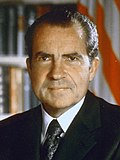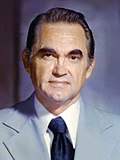| |||||||||||||||||||||||||||||||||
| Turnout | 81.39% | ||||||||||||||||||||||||||||||||
|---|---|---|---|---|---|---|---|---|---|---|---|---|---|---|---|---|---|---|---|---|---|---|---|---|---|---|---|---|---|---|---|---|---|
| |||||||||||||||||||||||||||||||||
 County Results
| |||||||||||||||||||||||||||||||||
| |||||||||||||||||||||||||||||||||
| Elections in Illinois |
|---|
 |
The 1968 United States presidential election in Illinois took place on November 5, 1968, as part of the overall 1968 United States presidential election. Illinois voters selected 26 electors to represent the state in the Electoral College, which would then choose the president and vice president.
Illinois had been consistently Republican during the "System of 1896," with the exception of a few areas in the southern part of the state that sympathized with the Confederacy during the American Civil War.[1] However, starting from the New Deal era, Illinois became a crucial swing state, having voted for the winner of every presidential election since 1920.
Like other states in the Midwest, Illinois had been severely affected by racial tension during the presidency of Lyndon Johnson.[2] This situation played a role in Charles H. Percy's comfortable Senate win, as he defeated Democrat Paul Douglas. Illinois, particularly the Metro East region, was affected less by racial tension compared to states located to its east.[3]
By the time the election campaign was in full swing at the end of the summer, Democratic nominee and incumbent Vice-President Hubert Humphrey was clearly in serious trouble, and early polling suggested he would have little chance in the state.[4] Humphrey was further hindered by the refusal of Chicago Mayor Richard Daley Sr. to help him.[5]
The failure of Nixon’s “50 State Strategy” in 1960 led him to focus on a few electoral-vote-rich states, of which Illinois was one of the most critical.[6] Humphrey lost further in polling during September,[7] and at the end of the first week of October Nixon had a substantial lead.[8] Nevertheless, when the Vice-President campaigned alongside rival former and future Alabama Governor George Wallace,[9] he would gain sharply so that state became extremely close at the beginning of November.
Cite error: There are <ref group=lower-alpha> tags or {{efn}} templates on this page, but the references will not show without a {{reflist|group=lower-alpha}} template or {{notelist}} template (see the help page).
- ^ Kleppner, Paul; The Evolution of American Electoral Systems, pp. 183, 201 ISBN 0313213798
- ^ Phillips, Kevin P.; The Emerging Republican Majority, pp. 398-399 ISBN 9780691163246
- ^ Edison, Jeffrey; ‘The Forgotten County: St. Clair County, Illinois, in 1968’ (thesis), p. 29. Published 2018 by Southern Illinois University at Edwardsville
- ^ Edwards, Owen Dudley; ‘No Escape Route for Humphrey on All Those Nasty Issues’; The Irish Times, 21 August 1968, p. 5
- ^ Healy, Robert; ‘Politics: It’s Still too Early To Pick Winner’; The Boston Globe, September 8, 1968, p. 6A
- ^ Mergel, Sarah Katherine; ‘A Report Card for Richard Nixon: Conservative Intellectuals and the President’ (thesis), p. 66. Published by The George Washington University, 2007
- ^ Janson, Donald; ‘Humphrey Losing Illinois Support: Wallace, With Rally Slated for Tomorrow, Is Factor’; The New York Times, September 29, 1968, p. 69
- ^ ‘Electoral Vote: Nixon 359, HHH 46’; The Boston Globe, October 7, 1968, p. 24
- ^ Janson, Donald; ‘Humphrey and Wallace to Stage Rival Rallies Friday in Chicago’; The New York Times, October 30, 1968, p. 30


